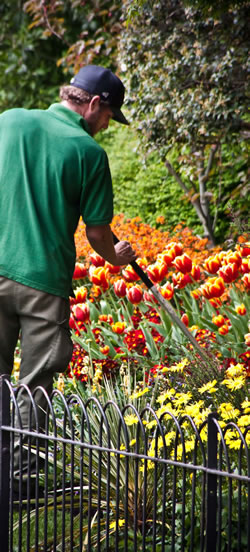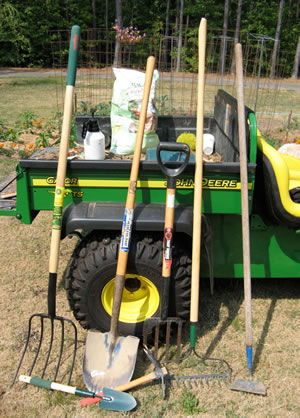Maintaining the Campus Landscape
 Summertime, and the living ain’t easy. This is the season when colleges and universities shoulder huge maintenance projects; taking advantage of the relative calm before the storm of students hits campus once again. Real maintenance professionals know that upkeep happens throughout the seasons, and in the case of landscaping and grounds, it starts before the first seed is planted. What does it take to keep grounds and landscapes well maintained? College Planning & Management goes digging for answers.
Summertime, and the living ain’t easy. This is the season when colleges and universities shoulder huge maintenance projects; taking advantage of the relative calm before the storm of students hits campus once again. Real maintenance professionals know that upkeep happens throughout the seasons, and in the case of landscaping and grounds, it starts before the first seed is planted. What does it take to keep grounds and landscapes well maintained? College Planning & Management goes digging for answers.
CHANGES IN POLICY AND PROCEDURES
Landscape maintenance has evolved through the years, to the benefit of the environment. “It used to be if you had a pest problem you just sprayed,” remembers Cary Avery, Grounds and Landscape Services associate director, University of California, Davis. “You didn’t think about long term effects on the environment or the beneficial insects that might be effected.”
Obviously environmental sustainability concerns are driving the shift. “An increasing number of colleges are adopting policy statements and implementing operational procedures that emphasize sustainable goals and that consider the local and global impacts of product use and services,” explains Joseph B. Jackson, Professional Grounds Management Society (PGMS) past president and retired facilities management director for Duke University in Durham, NC. “This means that it is not enough to just say that you’re doing the right thing with your maintenance activities, you have to support and verify your data.”
That data will be shared and scrutinized internally and externally. “Many landscapes are now being designed and installed to achieve and to be maintained at certain certification standards or to be judged by third-party peer evaluations such as LEED, the Sustainable Sites Initiative™ (SITES™) and the PGMS Landscape Management and Operations Accreditation (LMOA) program,” continues Jackson. “The maintenance complexities associated with this challenge are elevated by the expectation and requirement to deliver excellent landscape services while aiding in the reduction of the college’s carbon footprint.”
Maintaining to these standards has changed the landscaping game in many ways. “When you consider that many traditional college and university campuses are built around iconic open spaces covered in lawn, there is a fundamental conundrum about how to address them in a sustainable manner,” explains Mark Hough, PLA, ASLA, campus landscape architect, Duke University. “Harvard and UPenn are among those who have switched to using organic fertilizer (compost tea) and are having good results. Weed control is a tougher challenge — some schools are trying to go to hand weeding, but that adds considerable time and costs.”

PHOTO © HUMBOLDT STATE UNIVERSITY
NOT JUST A TRIM. Studies prove there are numerous human emotional and physical health benefits to a pleasant setting; therefore, campus landscaping professionals often work to create an enjoyable, passive, peaceful, relaxing outdoor environment for faculty, staff, students and visitors. A healthy landscape will include a diverse population of trees and ornamental plantings and also promotes an attractive campus by discouraging insect infestations and disease. Proper maintenance practices to ensure plant health include suitable watering, fertilization, pruning, pest control, conventional turf and tree care, landscape and hardscape installations and renovations, snow removal and emergency response.
A FOCUS ON FEEDBACK
Landscape professionals also need to manage customer expectations as well as a maintenance schedule. “Many years ago we had a landscape installed which included a sizable wildflower meadow,” says Thomas P. Flynn, senior landscape architect, The Pennsylvania State University (PSU), who answered questions together with maintenance supervisors Brian Phiel and Ron Eckenroth. “Unfortunately, many of our visitors were not ready for that more ‘rural’ aesthetic and we received complaints. The location was quickly turned into mowed turf.” The takeaway lesson from that experiment: “We created even larger areas that still get mowed but not as often,” Flynn reports. “Instead of once a week we mow them once a month now.” He blames the original glitch on timing. “These kinds of green landscapes are much more evident today so they don’t get the same negative reaction they received 10 years ago.”
Water usage and storm water control also presents unique challenges. “PSU has an unwritten policy that we don’t irrigate with potable water,” explains Flynn. “Certain years that policy makes it very difficult to maintain our campus landscape.” That conundrum has prodded Flynn and his team to investigate alternatives. “We now have three rainwater harvesting systems,” he reports. “They help greatly with managing our new plantings and regulating storm water.”
Taking the time to investigate water options is paramount, according to Hough. “I wonder how schools are maintaining all of these rain gardens and other storm water Best Management Practices (BMPs) they are installing,” he muses. “These are rarely as low maintenance as advertised and can end up creating headaches for crews.”
KEEPING UP WITH WEAR AND TEAR
 Good old wear and tear also adds to headaches for landscape professionals, especially in residential areas. “Our historic main quad is split into half residential and half academic and the residential side can look like a war zone after a school year,” says Hough. “There’s nothing a landscape crew can do to adequately deal with this.” He blames overuse and the subsequent soil compaction that comes with it.
Good old wear and tear also adds to headaches for landscape professionals, especially in residential areas. “Our historic main quad is split into half residential and half academic and the residential side can look like a war zone after a school year,” says Hough. “There’s nothing a landscape crew can do to adequately deal with this.” He blames overuse and the subsequent soil compaction that comes with it.
“The growing season for many plants — including grass — is spring and fall, but this is when the lawn gets used most,” Hough continues. “Everyone wants to love and use the campus landscape, but there needs to be balance. Otherwise it may not have any shot at surviving long enough for future students to enjoy.”
FUNDING, PLANNING AND MORE
The sluggish economy also drives changes in maintenance practices throughout a school, and the landscaping department is no exception. “Funding is the single biggest challenge in maintaining our campus grounds,” relates Flynn. “With ever-tightening budgets we have to find ways of servicing our landscapes more efficiently. In some cases we have totally eliminated certain maintenance practices.” The combination of reduced budgets and environmental goals means that Flynn’s team has altered the way they handle some tasks. “We changed the type of fertilizers we use and sweep dirt off of hardscapes,” he says as an example.
Avery agrees. “Financial sustainability is a challenge,” he says. “We not only need to convert traditional landscapes to more drought-tolerant, lower-maintenance landscapes, but we [also] need to understand that changing to a more regional, native landscape requires an investment that may take years to see a return on. Also we have to educate staff on how to maintain these landscapes and use new technology.”
All of these maintenance professionals agree that they must be called to the table at the beginning of any new project, even though that is not always the case. “Maintenance should always be a critical part of the equation if the design is to prove successful and sustainable,” argues Jackson. “The really good landscape designers realize how important it is to have or include maintenance expertise in the process.”
So what would a dream maintenance schedule look like?
“Wow!” exclaims Avery. “That would be one that was never affected by weather, events or plant pests or diseases or emergency requests.” His expectations, however, remain firmly rooted in reality. “You are working on living plants and dealing with lots of environmental factors that can change any schedule from day to day,” he says. “You have to be ready for anything.”
This article originally appeared in the College Planning & Management August 2013 issue of Spaces4Learning.